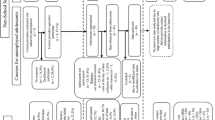Abstract
Objective
The purpose of the study was to investigate the prevalence of the use of a transitional object (TO) in adolescence and its connection with depressive symptoms and mental distress in youth by gender.
Method
The study group consisted of 1,054 adolescents (465 boys, 589 girls) from normal comprehensive schools in Turku, a Finnish town with approximately 175,000 inhabitants. The mean age of both gender groups was 14.5 years (SD 0.5); respondents came from all social classes. Background and TO information was collected with questionnaires. Depressive symptoms and mental distress were explored by the children’s depression inventory (CDI) and its subscales: low self-confidence, anhedonia and sadness.
Results
Of all respondents, 29% (n = 285) had a TO: 37% of girls and 18% of boys. The difference between genders was statistically significant. There was also a statistically significant gender difference in the character of the TO reported: 72 % of girls with a TO had a soft toy, whereas 49% of boys with a TO used hard objects, such as pens, hard toys or books. TO-users showed more depressive symptoms than non-users, but the difference was not statistically significant (P = 0.053). Significant differences were found in the CDI subscales: TO-users had more sadness than non-users and girls using a TO showed more sadness than non-using girls. TO-using boys did not differ from non-using boys with regard to sadness or the other CDI-subscales.
Conclusions
The use of a TO seems to be common in adolescence. Adolescents with more depressive symptoms more often used a TO. The sadness of girls using TOs requires attention.
Similar content being viewed by others
References
Adler G (1993) The psychotherapy of core borderline psychopathology. Am J Psychother 47:194–205
Aronen ET, Soininen M (2000) Childhood depressive symptoms predict psychiatric problems in young adults. Can J Psychiatry 45:465–470
Arthern J, Madill A (2002) How do transitional objects work? The client’s view. Psychother Res 12:369–388
Bacchar E, Canetti L, Galilee-Weisstub E, Kaplan-DeNour A, Shalev A (1998) Childhood vs. adolescence transitional object attachment, and its relation to mental health and parental bonding. Child Psychiatry Hum Dev 28:149–167
Bowlby J (1969) Attachment and loss, vol 1. Basic Books, New York
Brody S (1980) Idealization of a phenomenon. Psychoanal Q 49:561–605
Brooks SJ, Kutcher S (2001) Diagnosis and measurement of adolescent depression: a review of commonly utilized instruments. J Child Adolesc Psychopharmacol 11:341–376
Cardasis W, Hochman JA, Silk R (1997) Transitional objects and borderline disorder. Am J Psychiatry 154:250–255
Daws D (1993) Feeding problems and relationship difficulties: therapeutic work with parents and infants. J Child Psychother 19:69–83
Dockar-Drysdale B (1990) The provision of primary experience: Winnicottian work with children and adolescents. Free Associations Books, London
Erkolahti R, Ilonen T, Saarijärvi S, Terho P (2003) Self-image and depressive symptoms among adolescents in a non-clinical sample. Nord J Psychiatry 57:309–312
Gaddini R, Gaddini E (1970) Transitional objects and the process of individuation: a study in three different social groups. J Am Acad Child Psychiatry 9:347–365
Hong M, Townes BD (1976) Infants’ attachments to inanimate objects. A cross cultural study. J Am Acad Child Psychiatry 15:49–61
Ikeuchi H, Fujihara T (2004) Social psychological determinants of appearance of transitional objects: focusing of nursing environment. Jpn J Soc Psychol 19:184–194
Jernberg, Ann M (1979) Theraplay. Jossey-Bass, San Francisco
Kovacs M (1992) Children’s depression inventory manual. Multi-Health Systems, North Tonawanda
Kresanov K, Tuominen J, Piha J, Almqvist F (1998) Validity of child psychiatric screening methods. Eur Child Adolesc Psychiatry 7:85–95
Kumpulainen K, Räsänen E, Henttonen I, Hämäläinen M, Roine S (2000) The persistence of psychiatric deviance from the age of 8 to the age of 15 years. Soc Psychiatry Psychiatr Epidemiol 35:5–11
Laporta LD (1997) Borderline personality disorder and transitional objects. Am J Psychiatry 154:1484–1485
Mahler MS, Pine F, Bergman A (1975) The psychological birth of the human infant: symbiosis and individuation. Basic Books, New York
Markt C, Johnson M (1993) Transitional objects, pre-sleep rituals, and psychopathology. Child Psychiatry Hum Dev 23:161–173
Moilanen I (1991) Components of childhood depression. Rep Psychiatr Fenn 91:85–91
Morris H, Gunderson JG, Zanarini MC (1986) Transitional object use and borderline psychopathology. Am J Psychiatry 143:1534–1538
Roland A (1971) Imagery and symbolic expression in dreams and art. Int J Psychoanal 53:531–539
Samm A, Värnik A, Tooding LM, Sisask M, Kölves K, von Knorring AL (2007) Children’s depression inventory in Estonia: single items and factor structure by age and gender. Eur Child Adolesc Psychiatry 14 Sep [Epub ahead of print]
Shafii T (1986) The prevalence and use of transitional objects: a study of 230 adolescents. J Am Acad Child Psychiatry 25:805–808
Sherman M, Hertzig M, Austrian R, Shapiro T (1981) Treasured objects in school-aged children. Pediatrics 68:379–386
Tabin JK (1992) Transitional objects as objectifiers of the self in toddlers and adolescents. Bull Menninger Clin 56:209–220
Viberg L,Viberg M (2003) Nallen I psykologi. En prospektiv studie med focus på barns använding av övergångsobjekt. Akademisk avhandling. Lunds Universitet. Samhällsvetenskapliga fakulteten
Winnicott DW (1953) Transitional objects and transitional phenomena. Int J Psychoanal 34:89–96
Winnicott DW (1971) Playing and reality. Basic Books, New York
Winnicott DW (1965) The maturational processes and the facilitating environment. International Universities Press, New York
Winnicott DW (1966) The location of cultural experiences. Int J Psychoanal 48:368–372
Author information
Authors and Affiliations
Corresponding author
Rights and permissions
About this article
Cite this article
Erkolahti, R., Nyström, M. The prevalence of transitional object use in adolescence: is there a connection between the existence of a transitional object and depressive symptoms?. Eur Child Adolesc Psychiatry 18, 400–406 (2009). https://doi.org/10.1007/s00787-009-0747-7
Received:
Accepted:
Published:
Issue Date:
DOI: https://doi.org/10.1007/s00787-009-0747-7




